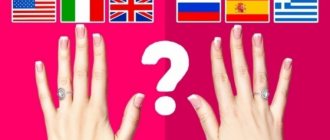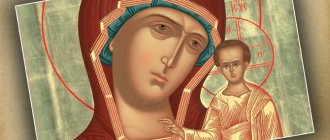This article is about the church celebration. For Slavic rituals, see Trinity Day.
The query "Descent of the Holy Spirit" redirects here; see also other meanings.
The request for "Pentecost" redirects here; for the Jewish holiday, see Shavuot.
| Day of the Holy Trinity | |
| El Greco. "Pentecost" | |
| Type | Christian, in a number of countries state |
| Otherwise | Holy Sunday of Pentecostia, Pentecost, Trinity Day, Trinity |
| Installed | in honor of the descent of the Holy Spirit on the apostles on the 50th day after Easter |
| Noted | by the majority of Christians in the world |
| date | 50th day (8th Sunday) after Easter, 10th day after Ascension |
| In 2020 | June 4 (Catholicism) May 22 (June 4) (Orthodoxy) |
| In 2020 | May 20 (Catholicism) May 14 (May 27) (Orthodoxy) |
| In 2020 | June 9 (Catholicism) June 3 (June 16) (Orthodoxy) |
| Celebration | worship services, festivals, folk celebrations |
| Associated with | Easter and Holy Spirit Day |
| Trinity Day at Wikimedia Commons | |
Day of the Holy Trinity
(abbr.
Trinity
),
Trinity Day, Pentecost
[1] (Greek Πεντηκοστή),
Pentecost
[2][3], (Greek Κυριακή της ἁγίας Πεντηκοστ ής[4]), sometimes
Spiritual Day
[5][6] - one of the main Christian holidays.
Orthodox churches celebrate Holy Trinity Day on Pentecost Sunday
- 50th day after Easter (Easter - 1st day). The holiday is one of the twelve holidays.
In the Western Christian tradition, Pentecost, or the descent of the Holy Spirit on the Apostles, is celebrated on this day, and Trinity Day itself is celebrated on the following Sunday (57th day after Easter).
In the New Testament
The descent of the Holy Spirit on the apostles on the day of Pentecost (Shavuot) is described in the Acts of the Holy Apostles (Acts 2:1-18). On the fiftieth day after the Resurrection of Jesus Christ (the tenth day after His ascension), the apostles were in the Zion Upper Room in Jerusalem, “... suddenly a sound came from heaven, as if from a rushing strong wind, and filled the whole house where they were. And cloven tongues as of fire appeared to them, and one rested on each of them. And they were all filled with the Holy Spirit, and began to speak in other tongues, as the Spirit gave them utterance.”
(Acts 2:2-4).
On this day, Jews from different cities and countries were in the city on the occasion of the holiday. Hearing the noise, they gathered in front of the house where the apostles were, and since “everyone heard them speaking in his own language”
(Acts 2:6), everyone was amazed.
Some of them mocked the apostles and “said, They are drunk of sweet wine”
(Acts 2:13). In response to this reaction:
Trinity in Orthodoxy
Pentecost was celebrated long before the emergence of the Christian religion. For this reason, many traditions, rituals, folk beliefs, customs and signs associated with this holiday are rooted in the era of paganism. People believed that Spiritual Day was the boundary between the summer and spring cycles. On Pentecost it was customary to organize dances, sing songs and summer barkers, conduct round dances, perform certain rituals, and tell fortunes.
Women and unmarried girls decorated their homes with bouquets consisting of green herbs, tree branches and the first summer flowers. The more fresh greens there were in the house, the better. It was believed that in this way one could negotiate with good spirits so that they would protect the family and provide all possible assistance until the next Trinity Sunday.
Pentecost is the day when mermaids, kikimoras, mermans, mawkas and other sea creatures emerged from reservoirs, lakes, rivers, seas and oceans. The grass and plants with which the home was decorated protected people from these spirits. For example, a mermaid could easily take the form of a beautiful maiden, seduce the boy she liked, lure him into the lake and drown him. As for male entities, most often a merman appeared to unmarried girls. He turned into a young, handsome guy, dragged the girl into the reed thickets and strangled her.
After the holiday, the greens were not thrown away, but were used as medicine. These folk “medicines” had enormous healing powers. They were used to treat migraines, diseases of the stomach and intestines, and also to get rid of infertility. From the young shoots of certain plants, which were collected in the forest and strictly at sunrise, potions were prepared that helped neutralize the evil magical effects (the evil eye and even fatal damage).
When the Orthodox faith did not exist, and people worshiped exclusively pagan gods, the holiday was called Semik or Green Sunday. On this day, believers honored those who controlled the earthly existence of people. According to one of the pagan teachings, they were three Deities - Perun, Svarog and Svyatozhich.
The First Deity personified justice and granted protection to all who needed it. The Second God created the Universe, controlled the Cosmos, sending beneficial energies to Earth. The Third God was the guardian of the created Universe. Svyatozhich ensured that Divine Light came to Earth and that ill-wishers did not invade the Heavenly Kingdom.
Name and interpretation
The holiday received its first name in honor of the descent of the Holy Spirit on the apostles, which Jesus Christ promised them before His ascension into heaven. The descent of the Holy Spirit indicated the trinity of God. What John Chrysostom writes about this:
| “And he filled the whole house.” The stormy breath was like a font of water; and fire serves as a sign of abundance and strength. This never happened to the prophets; it was like this only now - with the apostles; but with the prophets it is different. For example, Ezekiel is given a scroll of books, and he eats what he was supposed to say: “and it came to pass,” he says, “in my mouth it was as sweet as honey” (Ezek. 3:3). Or again: the hand of God touches the tongue of another prophet (Jer. 1:9). And here (everything is done) by the Holy Spirit himself and thus is equal to the Father and the Son[7] |
On the day of Pentecost, according to Bishop Alexander (Mileant), the universal apostolic Church was formed (Acts 2:41-47)[8].
The New Testament does not directly mention that the Mother of God was with the apostles at the descent of the Holy Spirit. The tradition of her presence in iconographic images of this event is based on the indication in the Acts of the Apostles that after the Ascension, the disciples of Jesus “continued with one accord in prayer and supplication, with certain women and Mary, the Mother of Jesus, and with His brothers.”
(Acts 1:14).
On this occasion, Bishop Innokenty (Borisov) writes: “ Could the one who conceived and gave birth through His medium not be present at the moment of the coming of the Holy Spirit?
"
Divine service
In Orthodoxy
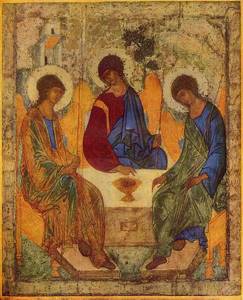
Name in liturgical books: “Sunday of Holy Penticostia”
(Church glory. Nedѣlѧ saints Pentikosti[2], Greek. Κυριακή της ἁγίας Πεντηκοστής[4]) On this day, one of the most solemn and beautiful services is performed in Orthodox churches per year.
The day before, on Saturday evening, a festive all-night vigil is served, at Great Vespers of which three proverbs are read: the first of them tells how the Holy Spirit descended on the righteous in the Old Testament (Num. 11:16-17 + Num. 11:24-29 ), the second (Joel 2:23-32) and third (Ezek. 36:24-28) proverbs, according to the faith of the Orthodox Church, are prophecies about the descent of the Holy Spirit on the apostles at Pentecost; for the first time after Great Lent, the famous stichera of the sixth tone to the Heavenly King is sung in stichera, which is repeated twice more after this at the matins of the all-night vigil; starting from this day, the prayer to the Heavenly King becomes the first prayer of the usual beginning of both church and home prayers. At Matins the polyeleos is served and the Gospel of John is read, the 65th conception (John 20:19-23); At Matins, two canons of this holiday are sung: the first was written by Cosmas of Mayum, the second by John of Damascus. On the holiday itself, a festive liturgy is served, at which the Apostle, 3rd Conception (Acts 2:1-11) is read and the composite Gospel of John, 27th Conception (John 7:37-52 + John 8:12) is read ). After the liturgy, the ninth hour and Great Vespers are served, at which stichera glorifying the descent of the Holy Spirit are sung; during Vespers, those praying three times, led by the priest, genuflect - they kneel, and the priest reads seven prayers (the first and second genuflections, the priest reads two prayers, and the third time - three prayers) for the Church, for the salvation of all those who pray and for the repose of the souls of all the departed (including those “ held in hell
”) - this ends the post-Easter period, during which no genuflections or prostrations are made in churches .
Troparion, kontakion and tribute on the Sunday of Holy Pentecost
| In Greek | In Church Slavonic (transliteration) | In Russian | |
| Troparion of the holiday, tone 8 (Ἦχος πλ. δ') | ? ? ένην σαγηνεύσας, φιλάνθρωπε, δόξα σοι. | Blessed are you, Christ our God, who are all wise fishers of phenomena, having sent down to them the Holy Spirit, and with them you caught the universe: Lover of mankind, glory to you | Blessed are You, Christ our God, who made the fishermen wise, sent down the Holy Spirit to them, and through them captured the universe. Lover of humanity, glory to You! |
| Kontakion of the holiday, tone 8 (Ἦχος πλ. δ') | Ὅτε καταβὰς τὰς γλώσσας συνέχεε, διεμέριζεν ἔθνη ὁ Ὕψιστος· ὅτε το ῦ πυρὸς τὰς γλώσσας διένειμεν, εἰς ἑνότητα πάντας ἐκάλεσε, καὶ συμφ ώνως δοξάζομεν τὸ πανάγιον Πνεῦμα. | Whenever the languages of the Most High descended, dividing the tongues, and when the fiery tongues were distributed, we all called into unity, and we glorified the All-Holy Spirit in agreement. | When the Most High came down and confused languages, He divided the nations; when He distributed tongues of fire, He called everyone to unity, and we, in agreement, glorify the All-Holy Spirit. |
| Honorer of the holiday, voice 4 (Ἦχος δ') | “Χαίροις Ἄνασσα, μητροπάρθενον κλέος. Ἄπαν γὰρ εὐδίνητον εὔλαλον στόμα. Ῥητρεῦον, οὐ σθένει σε μέλπειν ἀξίως. Ἰλιγγιᾷ δὲ νοῦς ἅπας σου τὸν τόκον Νοεῖν ὅθεν σε συμφώνως δοξάζ ομεν" | Rejoice, Queen, mother-maiden glory, for every kindly, benevolent mouth cannot flow, It is worthy to sing to You, but every mind is amazed to understand Your Christmas. Moreover, we glorify Thee in agreement. | Rejoice, Queen, glory to mothers and virgins! For no moving eloquent lips, speaking, can praise You worthily; Every mind also becomes weak, striving to comprehend the birth of Christ from You; therefore we glorify You accordingly. |
According to Russian tradition, the floor of the church (and the houses of believers) on this day is covered with freshly cut grass, the icons are decorated with birch branches, and the color of the vestments is green, depicting the life-giving and renewing power of the Holy Spirit (other Orthodox Churches also use white and gold vestments). The next day, Monday, is Holy Spirit Day.
In Catholicism
Main article: Trinity Day (Roman rite)
In the Catholic Church and in Lutheranism, the celebration of Pentecost (the Descent of the Holy Spirit) and the day of the Holy Trinity is divided, the day of the Holy Trinity is celebrated on the following Sunday after Pentecost. In the Catholic tradition, the celebration of the descent of the Holy Spirit opens the so-called “Pentecost cycle”. It includes:
- Trinity Day (Sunday, 7th day after Pentecost)
- Feast of the Body and Blood of Christ (Thursday, 11th day after Pentecost)
- Feast of the Sacred Heart of Jesus (Friday, 19th day after Pentecost)
- Feast of the Immaculate Heart of the Virgin Mary (Saturday, 20th day of Pentecost)
The holidays of the descent of the Holy Spirit and the day of the Holy Trinity have the highest status in the Roman liturgical calendar - celebrations. The colors of the vestments of the priests on the day of Pentecost are red, as a reminder of the “tongues of fire” that descended on the apostles; and on the day of the Holy Trinity - white, as on other great holidays. On the day of the descent of the Holy Spirit, two masses are celebrated according to different rites - the mass of the evening (on Saturday evening) and the mass of the day (on Sunday afternoon).
God, with the mystery of today’s holiday You sanctify Your Church, into which all nations are called. Send down abundant gifts of the Holy Spirit to the whole world and perform in the hearts of believers those miracles that You performed at the beginning of preaching the Gospel. Through our Lord Jesus Christ, Your Son, who lives and reigns with You in the unity of the Holy Spirit, God, forever and ever.
— Collected Mass on the Day of Pentecost
In some Eastern European countries (Poland, Belarus) and in Catholic churches in Russia there is also a tradition of decorating the temple with tree branches (birch).
Fortune telling for Trinity
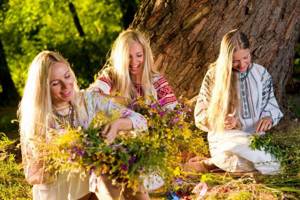
Trinity fortune telling “Feed the birds”
In the first half of the day, after visiting the temple, unmarried girls performed fortune-telling, which could tell whether matchmaking would take place this year. The girls went to the forest. They took with them one roe, baked especially for fortune telling. This bun was filled with rice, which symbolized marriage, abundance and prosperity in marriage.
Each girl chose a birch tree and hung her bun on a branch. To avoid accidentally tangling the buns, a ribbon of a certain color was tied to a branch next to it. Then the girl uttered the following words: “Birch maiden, tell me, will someone want to marry me?”
The roe remained hanging on the branch for 3 days. After the specified time, the girls returned to the forest and assessed the result. If the bun was completely pecked by the birds, it means that the girl will certainly be wooed soon. If the bun remained untouched, or the birds only pecked half of it, then the girl should go unmarried until the next Trinity.
Fortune telling on the holiday of the Trinity on the character of the husband
Any unmarried girl probably wants to know not only when the long-awaited wedding will take place, but also about the character and appearance of her future spouse. For this purpose, the girls gathered in the hut and laid out 9 specific objects on a large table. For each girl, fortune telling was carried out separately. One of the girls was blindfolded with a towel, spun around her axis and brought to the table. The girl had to blindly point her finger at one of the objects. The chosen subject was used to judge the main quality that her future husband would have.
Interpretations of objects
- Cast iron is an easy-going husband who will obey his wife in everything.
- The plate is a lazy husband.
- Saucer is a man with a very attractive appearance, caring and loving.
- Potato masher - the husband will be bald or with large bald patches, he will lose his hair early.
- Cup - kindness, responsiveness and willingness to help in everything.
- A spoon is a very wealthy spouse.
- Scoop - the spouse will “walk to the left.”
- Fork is a hard-working and skilled husband.
- Knife is a scandalous and stingy husband with an evil and vindictive character.
Fortune telling for Trinity “Who will be born - a boy or a girl?”
This fortune-telling was practiced by unmarried girls who wanted to find out the gender of their future first-born. Married women who have children and are planning to conceive another child could also take part in fortune telling. In Rus' it was extremely rare to find a family that did not have livestock. Almost every yard had chickens.
To find out who will be born to a girl/woman, you need to enter the chicken coop on the evening before Spiritual Day and say: “My dear hens, laying hens and quons, tell me who will be born to me - a son or a daughter?” Early in the morning on Trinity Sunday, you again need to go to the chicken coop and collect all the eggs laid by the chickens, bring them into the house and count them. If the number is even, it will be a boy, if it is odd, it will be a girl.
Fortune telling on the day of the Holy Trinity on the mirror
An ancient fortune telling that will tell you about the near future (for a year). You will need a small mirror and ash from the stove. In the evening on the eve of Trinity, before going to bed, you need to light a candle and, holding a mirror surface over its flame, say: “Burn the candle, lick the mirror with flame, and in the morning tell me my future. Zola will help you tell me about my fate."
After this, you need to put out the candle, sprinkle the mirror generously with ash, place it under the bed (at the head) and go to bed. The mirror should be placed very carefully so as not to disturb the ash layer. When you wake up, you need to carefully take out the mirror and evaluate what changes have occurred.
Interpretation of symbols
- Lines. Straight ones mean good luck in everything, wavy ones mean minor obstacles. Thin ones - problems in the family, thick ones - a long journey.
- Dots - mutual love.
- Curls, patterns - health problems.
- Circle - dreams will come true.
- Rectangle - tears, disappointments.
- Triangle - true friends will help.
- Square - the danger of betrayal on the part of a chosen one or relative.
- The surface remained untouched - a boring life, devoid of significant events, lack of optimism, a depressive state.
Advice! If images of objects, people or animals appear on the mirror surface, see interpretations that are suitable for fortune telling on coffee grounds.
Trinity fortune telling on flat cakes
For this fortune-telling, roes were specially baked - small round cakes. Instead of filling, small objects were placed inside the buns, each of which meant something. In the evening, unmarried girls and unmarried boys gathered around the fire. Everyone took one cake and broke it. What was inside characterized the person’s life in a future marriage.
Once the item was removed from the dough, the bun could be eaten. If there were a lot of people telling fortunes, a large number of goats were baked, and the objects that were placed inside could be repeated. For example, there could be 3 or 4 buns with the same filling.
Interpretations of objects
- Button making is hard work, you can only rely on yourself.
- Bead - many fans.
- Pin - tears, sadness, failures in love.
- Earring – there are no weddings planned this year.
- Ring - matchmaking.
- Brooch - life in luxury.
- Birch leaf – good health.
- The nail is envy, gossip around your name.
- Thimble - many children.
- A piece of ribbon - joy, fulfillment of desires.
- Coin – a comfortable life.
Trinity is the rebirth of nature, its final awakening from winter sleep. On this day, people glorify the Lord, thanking him for giving them new life through baptism, conveying the main truth of the universe and everything on Earth. On the day of the descent of the Holy Spirit, which took place on the top of Mount Sinai, everything around was blooming and green. Let everything in your life bloom, turn green and shine with the Divine Light. Happy Trinity!
Iconography
For more information on this topic, see Orthodox iconography of the Trinity.
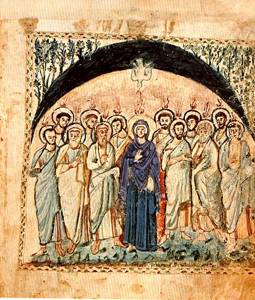
Descent of the Holy Spirit
(Gospel of Rabula, 6th century)
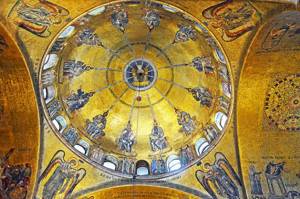
Dome of the Descent of the Holy Spirit
of the Cathedral of St. Stamp in Venice. Tongues of fire emanate from the etymasia with the dove; Below the apostles, between the windows, representatives of different nations are depicted
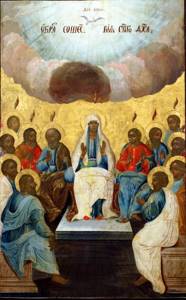
The Descent of the Holy Spirit
(icon from the Holy Spirit Church of the Novodevichy Convent, 18th century)
The development of the iconography of the holiday begins in the 6th century, its images appear in facial Gospels (Gospel of Rabula), mosaics and frescoes. Traditionally, the Upper Room of Zion is depicted, in which, according to the book of the Apostolic Acts, the apostles gathered. Books, scrolls are placed in their hands, or a blessing gesture is placed on their fingers (historically the gesture of an orator or preacher[9]).
The traditional characters in the scene of the descent of the Holy Spirit are:
- 12 apostles, and the place of Judas Iscariot is usually taken not by Matthias, but by Paul;
- sometimes - the Virgin Mary (known already from miniatures of the 6th century, then disappears in the Eastern tradition (preserved in the Western) and reappears on icons from the 17th century)[10].
The empty space between Peter and Paul (in compositions without the Virgin Mary) recalls the presence of the spirit absent from this second “Last Supper” of Jesus Christ[11]. The apostles, as a rule, are arranged in a horseshoe shape, which is also close iconographically to “Christ among the teachers.” The same composition, associated with the transfer to the plane of the traditional image of the Descent in the dome of the temple, will be repeated by the images of the Ecumenical Councils, since their task is to express the idea of conciliarity, community, clearly expressed here[10].
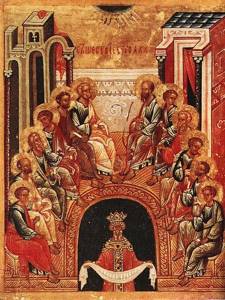
"The Descent of the Holy Spirit on the Apostles."
Archbishop's workshop in Veliky Novgorod. The turn of the XV-XVI centuries.
At the top of the icon, rays of light or flame are usually depicted. This descending fire is a way of depicting the descent of the Holy Spirit, based on the biblical description (Acts 2:3), along with which, especially in the Western tradition, the image of a descending dove, transferred from the description of the Baptism of the Lord, can be used.
In the lower part, inside the horseshoe-shaped composition, a dark space is left, indicating the first floor of a house in Jerusalem, under the upper room where the event took place. It may remain unfilled, thus associated with the empty tomb of Christ and the future resurrection of the dead, or with a world not yet enlightened by the apostolic preaching of the Gospel. Medieval miniatures here usually depicted (following the dome compositions) crowds of people from different countries who witnessed the descent of the Holy Spirit.[12] Later they are replaced (occasionally depicted with them[13]) by the figure of a king with twelve small scrolls on the canvas. There is an interpretation of this image as King David, whose prophecy about the resurrection of Christ was quoted by the Apostle Peter in his sermon (Acts) and whose grave is believed to be located on the first floor under the Zion upper room. Less common are interpretations of him as the prophet Joel, also quoted by Peter, Adam, the fallen Judas (cf. Acts 1:16), or Jesus Christ in the form of the Old Denmi, remaining with his disciples until the end of the age.[14]
Modern Greek icon of Pentecost. On the first floor, representatives of different nations are shown at a festival in Jerusalem; in the inset are David and Joel with the texts of the prophecies quoted by Peter.
A traditional, although late, interpretation is the understanding of the king as an image of the people to whom the gospel sermon is addressed and who is represented by the ruler.[10] In his hands, the king holds a stretched blanket on which 12 scrolls are laid - they symbolize the apostolic sermon (or, according to another interpretation, the totality of the peoples of the empire). In connection with this interpretation, the Greek inscription κόσμος - “world” [15] began to be placed next to the figure, according to which the image of the king received the name “Tsar-Cosmos” [16].
According to the philosopher Evgeny Trubetskoy, the image of the king on the icon symbolizes the Cosmos (Universe). In his work “Speculation in Colors” he wrote:
...down in the dungeon, under the arch, a prisoner is languishing - the “king of space” in the crown; and in the upper floor of the icon Pentecost is depicted: tongues of fire descend on the apostles sitting on thrones in the temple. From the very opposition of Pentecost to the cosmos and the king, it is clear that the temple where the apostles sit is understood as a new world and a new kingdom: this is the cosmic ideal that should lead the actual cosmos out of captivity; in order to give place within itself to this royal prisoner who must be freed, the temple must coincide with the universe: it must include within itself not only the new heaven, but also the new earth. And the tongues of fire above the apostles clearly show how the force that is to bring about this cosmic revolution is understood[17].
This interpretation, based on an expanded interpretation of the Greek word “κόσμος,” is also found among a number of art historians[18]. In the church environment, the concept of Tsar-Cosmos is used, but in the meaning of the world (Universe), without interpretations characteristic of secular philosophy[19].
Folk traditions
In Italy, in memory of the miracle of the descent of tongues of fire, it was customary to scatter rose petals from the ceiling of churches, and therefore this holiday in Sicily and other places in Italy was called Pasqua rosatum
(Easter of Roses).
Another Italian name, Pasqua rossa
, comes from the red color of the priestly robes of the Trinity.[20]
In France, during divine services, it was customary to blow trumpets, in remembrance of the sound of the strong wind that accompanied the descent of the Holy Spirit[20].
In the north-west of England, church and chapel processions, the so-called “Whit Walks” [21], were held on Trinity Sunday (sometimes on Spiritual Friday after Trinity). As a rule, brass bands and choirs took part in these processions; the girls were dressed in white. Traditionally, "Spirit Fairs" (sometimes called "Trinity Ales") were held. Trinity was associated with traditions of brewing beer, dancing the sea, organizing cheese races and archery tournaments[22].
According to a Finnish proverb, if you don't find a partner before Trinity, you will remain single for the entire next year.
In the Slavic folk tradition, the day is called Trinity or Trinity Day and is celebrated as a holiday either for one day (Sunday) or three days (from Sunday to Tuesday), and in general the period of Trinity holidays includes Midnight, Ascension, Semik, the week preceding Trinity, Trinity itself week, certain days of the week following Trinity, which are celebrated in order to avoid drought or hail or as a commemoration for unclean dead (primarily Thursday), as well as Peter's spell. Trinity completes the spring cycle, and after the next Peter's Fast, a new one begins - the summer season[6].
For more information on this topic, see Trinity Day.
See also: Maypole
What not to do on Trinity. Folk signs.
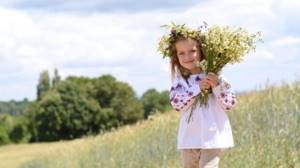
On Trinity Sunday, it is advised to visit the temple and bring there a bouquet of flowers and herbs. According to church rules, you cannot work or engage in physical labor on this day. Only some housework is allowed: cooking and feeding livestock. Cleaning is prohibited on this day.
You cannot sew, wash, cut, cut your hair, or dig the ground, plant plants, mow grass or cut down trees. You should also not be offended by loved ones, think about bad things and be sad. Weddings are not held on Trinity Sunday.
Rain is considered a good omen for Trinity. This means that the summer will be warm and sunny, and there will be a good harvest. But if it’s hot on Trinity Sunday, the summer will be dry.
There is an interesting ritual for Trinity, how to attract wealth to yourself. To do this, you need to lay out green grass or birch branches on the windowsill.
According to popular belief, it is better not to swim in bodies of water on Trinity Sunday, so as not to be dragged down by mermaids.
Pentecost in different languages
| From Greek Πεντηκοστή "Pentecost" | |
| Latin | lat. Pentecoste (similar in most Western European languages) |
| Old Church Slavonic | Art.-slav. Pentecost, Pentecost |
| Bulgarian | Teenage girl |
| German | Pfingsten |
| Swedish | Pingst |
| Slovenian | Binkošti (borrowed from German) |
| Hungarian | Pünkösd (borrowed from German) |
| From Lat. Rosalia, Pascha rosata “Festival of Roses, Pink Easter” | |
| Italian | Pasqua rosatum, Pasqua rossa |
| Neapolitan | Pasca rusata |
| Greek | Greek Ρουσάλια |
| Romanian | Rusalii |
| Albanian | Rrëshajët, rrushajët |
| Old Russian | other Russian Rѹsaliѩ |
| From the old glory. Trinity | |
| Russian | Trinity, Trinity Day |
| Slovak | Turice |
| Vepsian | Stroicanpäiv |
| Mokshansky | Trinity |
| Mari | Troychyn |
| Udmurt | Trocin |
| From "Spirit" | |
| Serbian | Dukhovy |
| Croatian | Duhovi |
| Macedonian | Dukhovden |
| Amharic | Päracliṭos - from Greek. παράκλητος “Comforter (epithet of the Holy Spirit)” |
| From “White Sunday” (based on the color of the catechumens’ clothes) | |
| English | Whitsun - from White Sunday |
| Welsh | Sulgwyn - from (Dydd) Sul "Sunday" + gwyn "white, holy, blessed" |
| Faroese | Hvitusunna |
| Icelandic | Hvitasunnu-dagr |
| Other | |
| Finnish | Helluntai - from ancient Scand. hælgho dagher "holy days" |
| Latvian | Vasarsvētki "summer holiday" |
| Czech | Letnice |
| Ossetian | Kærdæghæssæn “grass transfer” |
Notes
- Pechatnov, 2020, p. 89.
- ↑ 12
Triodion Colored - A clergyman's handbook. Volume 4. - Triodion of Lenten and Colored - Holy Trinity. Pentecost - Chapter 2. Sunday of Holy Pentecost. Day of the Holy Trinity. — P. 474.
- ↑ 12
ΠΕΝΤΗΚΟΣΤΑΡΙΟΝ (inaccessible link) - Katovich, Kruk, 2009, p. 105.
- ↑ 12
Agapkina, 2012, p. 320. - John Chrysostom. Commentaries on the book of Acts of the Saints. Conversation 4.
- Bishop Alexander (Mileant) “The Feast of the Holy Trinity is the day of the descent of the Holy Spirit on the Apostles” Birthday of the Church. Archived copy from June 2, 2020 on the Wayback Machine
- Dmitry Marchenko.
“Rocker goat” on Orthodox icons, or What is important to remember about gestures in iconography Archival copy dated May 12, 2013 on the Wayback Machine - ↑ 123
A. Moiseenkov Iconography of the Feast of Pentecost. How the descent of the Holy Spirit on the Apostles was depicted in different eras - Alfredo Tradigo. Icons and Saints of the Eastern Orthodox Church. Getty Publications, 2006. P. 151. (English)
- Barbarians and Cynocephali symbolizing the apostolic witness “to the ends of the earth” in an Armenian miniature of the 13th century
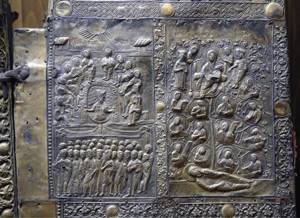
- Iconography of the image “The Descent of the Holy Spirit on the Apostles”
- Erminia Dionisia Furnoagrafiota
- Descent of the Holy Spirit on the Apostles (Pentecost, Trinity)
- Book E. Trubetskoy. Speculation in colors
- Ignashina E. V., Komarova Yu. B.
Russian icon of the 11th-19th centuries in the collection of the Novgorod Museum. Exhibition guide. - M.: Northern Pilgrim, 2004. - P. 98. - Archpriest Nikolai Pogrebnyak.
Birth of the Church of Christ. Notes on the iconography of the Descent of the Holy Spirit on the Apostles (inaccessible link) // Moscow Diocesan Gazette. 2003. No. 4-5. - ↑ 1 2 Holweck F.
Pentecost (Whitsunday) // The Catholic Encyclopedia. Vol. 15. New York: Robert Appleton Company, 1912. - Whit Friday: Whit Walks Archived May 9, 2008 on the Wayback Machine
- 'Feasts and Festivals': 23 May: Whitsun Ales
The meaning of Holy Trinity Day
Archpriest Igor Fomin, rector of the Alexander Nevsky Church at MGIMO, cleric of the Cathedral of the Icon of the Kazan Mother of God on Red Square.
“Pentecost is the birthday of the Church of Christ. The Lord unites all believers around Him - those who want to follow Him, live according to His commandments, and overcome their death by His death.
The Babylonian dispersion of the nations, which we read about in the Old Testament, is overcome precisely on the day of Pentecost. The Lord again gathers people who think and work on their salvation. And all in order to later bring them into the Kingdom of Heaven.”
Literature
- Trinity / T. A. Agapkina // Slavic antiquities: Ethnolinguistic dictionary: in 5 volumes / edited by. ed. N. I. Tolstoy; Institute of Slavic Studies RAS. — M.: Intl. relations, 2012. - T. 5: S (Fairy Tale) - I (Lizard). — P. 320–325. — ISBN 978-5-7133-1380-7.
- Katovich A., Kruk J.
Summer Saints. Book 1. Issued. - Mn.: Adukatsiya i vyakhavanne, 2009. - 368 p. — ISBN 978-985-6029-99-1. (Belorian) - Pentecost / Pechatnov V.V. // Motherwort - Rumcherod. - M.: Great Russian Encyclopedia, 2020. - P. 89-90. - (Great Russian Encyclopedia: [in 35 volumes] / chief editor Yu. S. Osipov; 2004-2017, vol. 28). — ISBN 978-5-85270-365-1.
